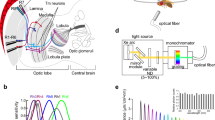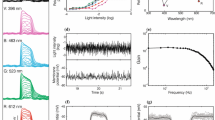Summary
Three different methods were used to determine the spectral sensitivity of retinula cells in the compound eyes of three species of hymenopteran insects (Apis mellifera, Melipona quadrifasciata, Osmia rufa). The conventional flash method gives the least reliable results. Sensitivity is extremely sensitive to small fluctuations of the resting potential and long lasting changes induced by preceding test flashes. The ramp method, which speeds up a spectral scan to about 1 min and keeps effective illumination constant at every flash, determines S(λ) much more reliably. The best results are obtained with the spectral scan method, which provides the experimenter with aS(λ) function of high spectral resolution within 20 s. Using this method we demonstrate that the high observed variability inS(λ) of individual receptors is the result of the inadequacy of the flash method, which was the only method used in earlier studies.
Double microelectrode experiments and variations of the stimulus conditions reveal that field potentials and return flow of electric current produced by activated neighboring cells have no effect in the bee eye. We conclude that the model of Shaw (1975, 1981) of current flow in the locust and fly eye does not apply to the bee eye. Very rare recordings (about 1%) of UV receptors with hyperpolarizing responses to long wavelength light are interpreted as having a synaptic inhibitory connection to green receptors.
The improvement of spectral measurements of single receptors allows us for the first time to model the spectral input to a color-coding network with great precision.
Similar content being viewed by others
References
Autrum H, Burkhardt D (1960) Die spektrale Empfindlichkeit einzelner Sehzellen. Naturwissenschaften 47:527
Autrum H, Zwehl V von (1964) Spektrale Empfindlichkeit einzelner Sehzellen des Bienenauges. Z Vergl Physiol 48:357–384
Burkhardt D (1962) Spectral sensitivity and other responses of single visual cells in the arthropod eye. Symp Soc Exp Biol 16:86–109
Burkhardt D, Autrum H (1960) Die Belichtungspotentiale einzelner Sehzellen vonCalliphora erythrocephala. Z Naturforsch 15b:612–616
Coles JA, Tsacopoulos M (1979) Potassium activity in photoreceptors, glia cells and extracellular space in the drone retina: changes during photo-stimulation. J Physiol 290:525–549
Daumer K (1956) Reizmetrische Untersuchungen des Farbensehens der Bienen. Z Vergl Physiol 38:413–478
Erber J, Menzel R (1977) Visual interneurons in the median protocerebrum of the bee. J Comp Physiol 121:65–77
Fleissner G (1982) Isolation of an insect circadian clock. J Comp Physiol 149:311–316
Franceschini N (1984) Chromatic organization and sexual dimorphism of the fly retinal mosaic. In: Borsellino A, Cervetto L (eds) Photoreceptors. Plenum Corp, pp 319–350
Frisch K von (1914) Der Farbensinn und Formensinn der Biene. Zool Jahrb Abt Allgem Zool Physiol 35:1–188
Hamdorf K, Paulsen R, Schwemer J (1973) Photoregeneration and sensitivity control of photoreceptors in invertebrates. In: Langer H (ed) Biochemistry and physiology of visual pigments. Springer, Berlin Heidelberg New York
Hardie RC (1979) Electrophysiological analysis of fly retina. I. Comparative properties of R1-6 and R7 and 8. J Comp Physiol 129:19–33
Hardie RC, Kirschfeld K (1983) Ultraviolet sensitivity of fly photoreceptors R7 and R8. Evidence for a sensitizing function. Biophys Struct Mech 9:171–180
Hardie RC, Franceschini N, McIntyre PD (1979) Electrophysiological analysis of fly retina. II. Spectral and polarization sensitivity in R7 and R8. J Comp Physiol 133:23–39
Heiversen O von (1972) Zur spektralen Unterschiedsempfindlichkeit der Honigbiene. J Comp Physiol 80:439–472
Hertel H (1980) Chromatic properties of identified interneurons in the optic lobes of the bee. J Comp Physiol 137:215–231
Hertel H, Ventura D (1985) Spectral sensitivity of photoreceptors in the compound eye of stingless tropical bees. J Insect Physiol 31:931–935
Horridge GA, Marcelja L, Jahnke R, Matic T (1983) Single electrode studies on the retina of the butterflyPapilio. J Comp Physiol 150:271–294
Horridge GA, Marcelja L, Jahnke R (1984) Colour vision in butterflies. Single colour experiments. J Comp Physiol A 155:529–542
Kien J, Menzel R (1977a) Chromatic properties of interneurons in the optic lobe of the bee. I. Broad band neurons. J Comp Physiol 113:17–34
Kien J, Menzel R (1977b) Chromatic properties of interneurons in the optic lobe of the bee. II. Narrow band and colour opponent neurons. J Comp Physiol 113:35–53
Kirschfeld K, Franceschini N, Minke B (1977) Evidence for a sensitizing pigment in fly photoreceptors. Nature 269:386–390
Langer H, Schneider L (1972) Lichtsinneszellen. In: Ruska (ed) Lehrbuch der Cytologie. VEB Fischer, Jena
Lipetz LE (1971) The relation of physiological and psychological aspects of sensory intensity. In: Loewenstein WR (ed) Principles of receptor physiology (Handbook of sensory physiology, vol I) Springer, Berlin Heidelberg New York, pp 191–225
Matic T, Laughlin SB (1981) Changes in the intensity-response function of an insect's photoreceptors due to light adaptation. J Comp Physiol 145:169–178
Menzel R (1974) Colour receptor in insects. In: Horridge GA (ed) The compound eye and vision in insects. Clarendon Press, Oxford, pp 121–153
Menzel R (1979) Spectral sensitivity and color vision in invertebrates. In: Autrum H (ed) Vision in invertebrates (Hand-book of sensory physiology, vol VII/6A) Springer, Berlin Heidelberg New York, pp 504–580
Menzel R (1985) Colour pathways and colour vision in the honeybee. In: Zeki S (ed) Central and peripheral mechanisms of colour vision. Pergamon Press, Oxford London, pp 211–233
Menzel R, Blakers M (1976) Colour receptors in the bee eye — morphology and spectral sensitivity. J Comp Physiol 108:11–33
Menzel R, Erber J, Greggers U (1978) On-line computation of photoreceptor spectral sensitivity — a low-cost solution — with a programmable pocket calculator. Vision Res 18:879–882
Milde J (1982) Elektrophysiologische und anatomische Untersuchungen an Interneuronen erster und höherer Ordnung des Ocellensystems der Biene (Apis mellifica carnica). FU Berlin, Dissertation
Riehle A (1981) Color opponent neurons of the honey bee in a heterochromatic flicker test. J Comp Physiol 142:81–88
Schäfer S (1984) Charakterisierung extrinsischer Großfeldneuronen aus der Medulla der Honigbiene (Apis mellifera). FU Berlin, Diplomarbeit
Schlecht P (1979) Colour discrimination in dim light: An analysis of the photoreceptor arrangement in the moth,Deilephila. J Comp Physiol 129:257–267
Shaw SR (1969) Interreceptor coupling in ommatidia of drone honeybee and locust compound eye. Vision Res 9:999–1029
Shaw SR (1975) Retinal resistance barriers and electrical lateral inhibition. Nature 255:480–483
Shaw SR (1977) Restricted diffusion and extracellular space in the insect retina. J Comp Physiol 113:257–282
Shaw SR (1981) Anatomy and physiology of identified nonspiking cells in the photoreceptor-lamina complex of the compound eye of insects, especially Diptera. In: Roberts A, Bush BMH (eds) Neurones without impulses. University Press, Cambridge MA, pp 61–116
Smakman JGJ, Pijpker BA (1983) An analog-digital feedback system for measuring photoreceptor properties with an equal response method. J Neurosci Meth 8:365–373
Snyder AW, Menzel R, Laughlin SB (1973) Structure and function of the fused rhabdom. J Comp Physiol 87:99–135
Vogt K (1984) The chromophore of the visual pigment in some insect orders. Z Naturforsch 39c: 196–197
Wehner R, Bernard GD (1980) Intracellular optical physiology of the bee's eye. II. Polarizational sensitivity. J Comp Physiol 137:205–214
Author information
Authors and Affiliations
Rights and permissions
About this article
Cite this article
Menzel, R., Ventura, D.F., Hertel, H. et al. Spectral sensitivity of photoreceptors in insect compound eyes: Comparison of species and methods. J. Comp. Physiol. 158, 165–177 (1986). https://doi.org/10.1007/BF01338560
Accepted:
Issue Date:
DOI: https://doi.org/10.1007/BF01338560




